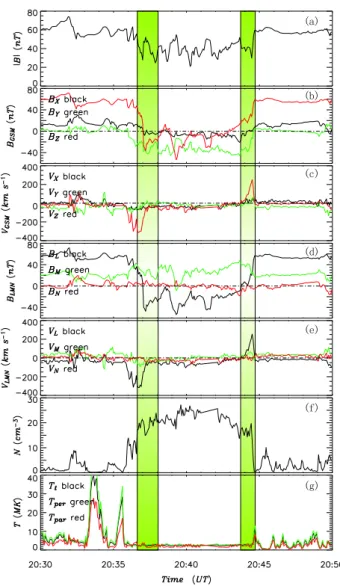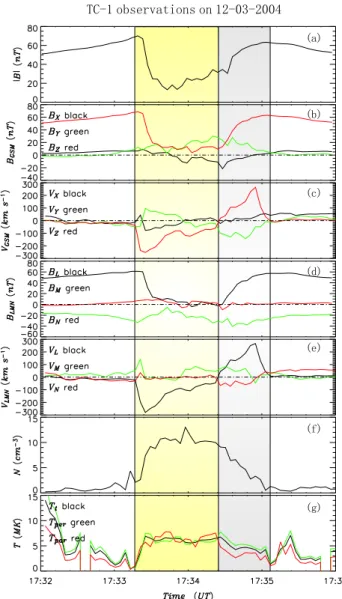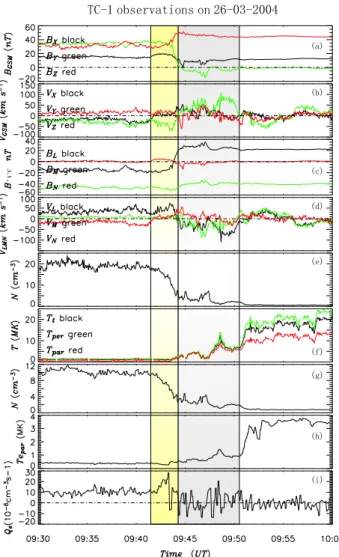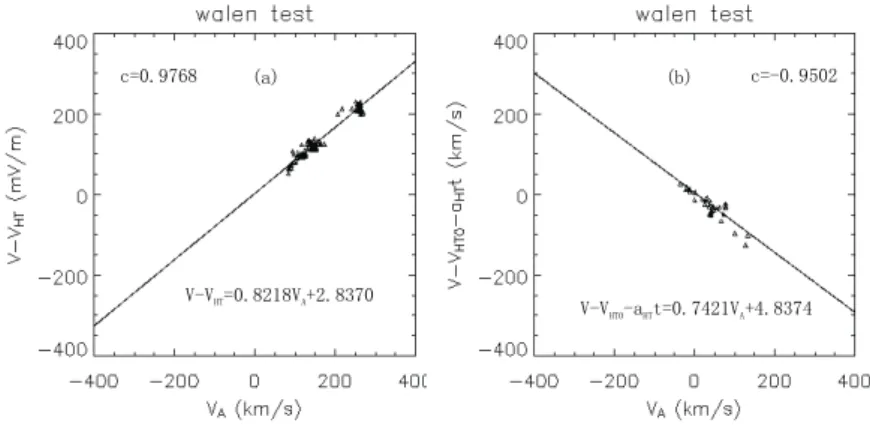SRef-ID: 1432-0576/ag/2005-23-2889 © European Geosciences Union 2005
Annales
Geophysicae
Double Star TC-1 observations of component reconnection at the
dayside magnetopause: a preliminary study
Z. Y. Pu1,3, C. J. Xiao2, X. G. Zhang1, Z. Y. Huang1, S. Y. Fu1, Z. X. Liu3, M. W. Dunlop4, Q. G. Zong5, C. M. Carr6, H. R´eme7, I. Dandouras7, A. Fazakerley8, T. Phan9, T. L. Zhang10, H. Zhang1, and X. G. Wang11
1School of Earth and Space Sciences, Peking University, Beijing 100871, China
2National Astronomical Observatories, Chinese Academy of Science, Beijing 100012, China
3Center for Space Science and Applied Research, Chinese Academy of Science, Beijing 100080, China
4Space Science and Technology Department, Rutherford Appleton Laboratory, Chilton, Oxfordshire, OX11 0QX, UK 5Center for Space Physics, Boston University, Boston, Mass 02215, USA
6SAPG, The Blackett Laboratory, Imperial College, London SW7 2BZ, UK
7Centre d’Etudes Spatiale des Rayonnements, BP 4346, 31028 Toulouse cedex 4, France 8Mullard Space Science Laboratory, University College London, Surrey RH5 6NT, UK 9Space Science Laboratory, University of California Berkeley, Berkeley CA 94720, USA 10Space Research Institute, Austrian Academy of Sciences, OAW, Graz, A-8010, Austria 11Center for Plasma Physics, Dalian Univerity of Science and Technology, Dalian 116024, China
Received: 14 February 2005 – Revised: 2 August 2005 – Accepted: 19 August 2005 – Published: 8 November 2005 Part of Special Issue “Double Star – First Results”
Abstract.In spring 2004 Double Star TC-1 measured a num-ber of reconnection signatures at the dayside low-latitude magnetopause (MP) when there was a notable By
compo-nent in the magnetosheath. In a number of events we can show that reconnection was operating nearby TC-1 in the subsolar MP region. In this paper we describe three rep-resentative events: (a) event on 21 March 2004 in which the reconnection site can be remotely monitored, the space-craft was passing by the X-line; (b) event on 12 March 2004 in which TC-1 observed the magnetospheric part of the quadrupolar field, together with a consistent flow reversal; (c) event on 26 March 2004 which occurred for northward IMF, TC-1 observed a reversal ofvy across the equatorial
MP. In these events the shear angles across the MP were considerably smaller than 180◦; a noticeable guide field was
present. These observations are consistent with near equato-rial component merging, suggesting that component recon-nection preferably occurs at the dayside low-latitude MP. There is evidence that when a pronounced magnetic shear across the MP exists in theBycomponent, reconnection may
operate at the dayside low-latitude MP for northward IMF Bz.
Keywords. Space plasma physics (Magnetic reconnection) – Magnetospheric physics (Magnetopause, cusp, arid bound-ary layers; Solar wind-magnetosphere interactions)
Correspondence to:Z. Y. Pu (zypu@pku.edu.cn)
1 Introduction
Magnetic reconnection at the magnetopause (MP) is the pri-mary mechanism responsible for the transfer of solar wind energy and plasma into the magnetosphere. Previous ob-servations have considerably increased our understanding of this key process in the solar wind-magnetosphere coupling (Paschmann et al., 1979; Sonnerup et al., 1981; Russell and Elphic, 1978; Gosling, 1990).
However, some fundamental questions remain unclear. It is not yet quite known where reconnection first occurs and how the resulting structure moves (Cooling et al., 2001). Whether reconnection can operate at the dayside low-latitude MP for northward IMFBzis also a matter of ongoing
discus-sions. The anti-parallel merging model (Crooker, 1979; Luh-mann et al., 1984) suggests that when a non-zero interplan-etary magnetic field (IMF)By is present, MP reconnection
Fig. 1.TC-1 measurements for the two magnetopause crossings on 21 March 2004 (details are shown in the text).
recently been observed by Cluster (Zong et al., 2003). On the other hand, at the low-latitude MP, reconnection signa-tures have been detected for a large range of IMF orienta-tion (Scurry et al., 1994). ISEE observaorienta-tions of flux transfer events (FTEs) (Russell and Elphic, 1978) when the IMF is not due southward are consistent with near equatorial com-ponent merging (Russell et al., 1985). Particle distribution measurements by AMPTE/CCE and Polar spacecraft suggest that for northward IMF, reconnection happens on the tailward side of the cusp (Song and Russell, 1992), as well as equa-torward of the cusp on the dayside (Onsager and Fuselier, 1994; Fuselier et al., 1997; Chandler et al., 1999). Neverthe-less, direct observations of reconnecting magnetic fields and accelerated plasmas are highly required to verify this sugges-tion.
The Double Star TC-1 orbit has an apogee of∼12.4RE,
a perigee of 577 km, an inclination of 28.25◦, and an orbital
2 Observations
A number of events exist in which ongoing reconnection was not far from TC-1 at the dayside low-latitude MP. This sec-tion presents three representative events.
2.1 Event 21 March 2004
First we show an event in which the reconnection site can be remotely monitored. Around 20:40 UT on 21 March 2004, TC-1 was located at ∼(10.3, –1.4, –2.5)RE(GSM).
Figure 1 shows, from top to bottom, the total magnetic field (a), the three components of the magnetic field and the ther-mal ion velocity in the GSM coordinate system (b and c) and in the MP local boundary system (d and e), thermal ion density (f) and temperature (g). In the local MP coordi-natesL,MandNrepresent, respectively, the direction of the maximum, intermediate and minimum variance of the mea-sured magnetic field and positiveN is outward (Sonnerup and Schelible, 1998). In reconnection, merging happens in theL-component; theMandNindicates the guide field and normal field direction, respectively.
At∼20:36 UT TC-1 went out from the magnetosphere to the magnetosheath; at∼20:44 it returned back to the magne-tosphere. During this time Cluster stayed just sunward of the bow shock and observed a southwardBz with a noticeable
dawnwardBy for the time period of 20:32–20:40 UT (not
shown here). During the outbound and inbound MP cross-ing, TC-1 detected a southward (–z-direction) and northward (+z-direction) jet, respectively. Thevzcomponent of the jets
reached∼320 km/s, much higher than the background mag-netosheath flow. It is of interest to note that in the MP cur-rent layerBN, the magnetic field component normal to the
local MP has a weak nonzero value that was positive (neg-ative) for the southward (northward) jet. Therefore, accord-ing to the classical reconnection picture, duraccord-ing the outbound and inbound MP traversals, TC-1 was on the southern and northern sides of the X-line, respectively (Phan et al., 2000). This is consistent with the fact that bothvzandvLwere
di-rected southward and that in the time interval between the outbound and inbound MP crossing, the z-component of the DeHoffmann-Teller frame velocity (VH T)z (Khraborv and
Fig. 2.Wal´en scatter plot for(a)the outbound MP crossing and(b)the inbound MP crossing on 21 March 2004.
crossing, respectively, whereVAdenotes the corresponding Alfv´en velocity, andv
−VH T stands for the plasma velocity
in the DeHoffmann-Teller (HT) frame (Khraborv and Son-nerup, 1998).
The slopes of the regression lines and the correlation co-efficients are not far from unit, intimating a good Alfv´enic nature of the boundary flows of the MP reconnection (Son-nerup, 1995). The slope signs are in agreement with the signs of BN, i.e. a negative slope matchesBN>0 and a positive
slope corresponds toBN<0 (Sonnerup et al., 1995; Phan et
al., 2004).
2.2 Event 12 March 2004
Secondly, we show an event on 12 March 2004 in which TC-1 observed the quadrupolar field in/near the diffusion region. During this event the TC-1 GSM coordinates were∼(10.6, –0.4, –1.8)RE. Geotail was situated at ∼(–9.9, –22.8, –
9.8)RE (GSM) and observed a southward IMF with
non-zeroBy for the period of interest. Figure 3 plots the same
variables as in Fig. 1. At∼17:33:12 UT the MP suddenly moved inwards, and returned back at∼17:34:48. At these two time instances, TC-1 observed a pair of opposite jets in the MP boundary layer of which thevLcomponent reached ∼∓250km/s. As in Fig. 1 positivevLindicates a northward
flow and positiveBNdenotes an outward magnetic field. The
spacecraft thus stayed northward and southward of the X-line at these two instances, respectively. Of interest is the fact that the reversal ofvLcoincided exactly with the reversal of
BN. Notice also that variations ofBL,BM (relative to the
averaged background value),BN andvL between 17:33:15
and 17:35:10 UT are consistent with the prediction of the Hall effect in the ion inertial region (Sonnerup, 1979). The quadrupolar fields in/near the diffusion region have already been observed at the MP (Mozer et al., 2002; Deng and Mat-sumoto, 2001), as well as in the magnetotail (Nagai et al., 2001; Øieroset et al., 2001). In this event TC-1 was pass-ing by the diffusion region and observed the magnetospheric half of the quadrupolar field, together with a consistent rapid reversal ofvL. The yellow and gray shadow in Fig. 3
repre-sents, respectively, the area southward and northward of the
Fig. 4.TC-1 measurements during the inbound crossing of the mag-netopause on 26 March 2004 (details are in the text).
X-line. The X-line in the center of the diffusion region was thus not far from the TC-1 position. Note that at the reversals ofBNandvL, the background guide fieldBMwas≈–28 nT.
2.3 Event 26 March 2004
The third event was a low magnetic shear event observed around∼09:40:24 UT on 26 March 2004 when TC-1 GSM coordinates were∼(10.4, –2.2, –1.4)RE. During this event,
Cluster was located in the solar wind just sunward of the bow shock. The Cluster measurement showed that the IMF had a northward orientation with a positiveBy. In the time period
of interest, IMFBzandBywere 6 nT and 9 nT, respectively.
Figure 4 displays the measurements of variables similar to those in Fig. 1. In addition, the bottom three panels show the electron density (g), temperature (h) and heat flux paral-lel to the magnetic field (i) measured by TC-1 PEACE. It is seen that while traversing from the magnetosheath into the magnetosphere, Bz increased from 30 nT to 50 nT and By
dropped from 40 nT to –5 nT. In the meantime, TC-1 encoun-tered a high speed dawnward flow inside the magnetospheric
The magnitudes of the Wal´en slopes and correlation coeffi-cients were both close to unit, which further supports that TC-1 encountered a merging region while traversing through the MP.
Scurry et al. (1994) reported that low magnetic shear events occur only when the sheath beta is low. By using solar wind and magnetic field parameters measured in the adjacent magnetosheath, we obtain that the magnetosheath beta in this event was≈0.09, much lower than that in event 21 March 2004 (≈1.35). TC-1 was thus located in the depletion layer in the magnetosheath (Phan and Paschmann, 1995). The mag-netic field topology near the merging site will be studied in a future paper.
In short, the reconnection in this event occurred for a northward IMFBznearby TC-1 at the dayside low-latitude
MP.
3 Discussion
There are several events in the TC-1 reconnection list which are similar to the three described in the previous section. These observations support the component merging hypoth-esis and provide new evidence for dayside reconnection for northward IMFBzwhen an IMFByis present.
3.1 Component versus anti-parallel reconnection
The most straightforward way to distinguish component and anti-parallel reconnection is to determine if there is a guide field at/near the reconnection site, or whether the shear an-gle across its local MP noticeably deviates from 180◦. In
the 21 March event TC-1 passed nearby the X-line on the magnetosheath side. Figure 1 shows that the magnetospheric field measured before and after the two jets was fairly quiet withBL≈60 nT andBM≈20 nT, while between the two jets,
the magnetosheath field was fluctuating around the averaged values ofBL≈–35 nT andBM≈+35 nT. We then obtain that
the averaged shear angle across the MP near the X-line was ∼116◦. In event 26 March the shear angle across the lo-cal MP can be estimated to be 57◦due to the presence of a
strong guide field of∼−40 nT (seeBMcomponent in Fig. 4).
In addition, avyreversal from being dawnward in the
Fig. 5. Wal´en scatter plot for magnetopause crossing on 26 March 2004,(a)on the magnetosheath side and(b)on the magnetospheric side.
reversal at the MP for strong IMF By can only be
accom-plished by a low-latitude component reconnection. There are several other events not presented here which possess the analogous features to the above two events. These ob-servations are apparently consistent with the near equatorial component merging model.
In event 12 March, TC-1 observed a rapid reversal ofvL,
together with the magnetospheric part of the quadrupolar field caused by the Hall current in/near the ion inertial re-gion. The reconnection site at the MP current sheet was not far from the TC-1 position. As Fig. 3 shows, right at the re-versal ofvLandBN, a non-zero backgroundBM (∼−28 nT)
existed. In the present paper we consider this as a guide field and regard the 12 March event as evidence for component merging. A similar structure has recently been observed in the high-latitude MP boundary (Zong et al., 2005). Further studies of this type of events are highly required.
In a statistical study of accelerated flow events measured by ISSE 2 spacecraft, Scurry et al. (1994) found that merg-ing occurs in the subsolar region for a wide range of magnetic shear angle across the MP. The anti-parallel merging hypoth-esis cannot completely explain the dayside merging pattern. The TC-1 observations provide further evidence that when a nonzero IMFByexists, component reconnection occurs at
the dayside low-latitude MP.
3.2 Dayside reconnection for northward IMFBz
Reconnection occurring tailward of the cusp when the IMF is directed northward has been observed and expected to form the dayside low-latitude boundary layer and proton aurora (Song and Russell, 1992; Phan et al., 2003). By studying the ion and electron data within the dayside LLBL, some au-thors have shown that component reconnection also occurs equatorward of the cusp for northward IMF (Onsager and Fuselier, 1994; Fuselier et al., 1997; Chandler et al., 1999). We have found evidence (event 26 March 2004) that recon-nection can occur for a northward IMF Bz at the dayside
low-latitude MP. Both reconnecting magnetic field geome-try and the reversal of accelerated flow were clearly seen.
There are a few other similar events in the TC-1 list. These observations provide significant new evidence that reconnec-tion may also take place at the low-latitude dayside magne-topause MP for northward IMF. As Fig. 4 indicates this hap-pened when pronounced magnetic shear across the MP ex-isted in the y-direction, which affords further evidence con-sistent with dayside low-latitude component merging. Nev-ertheless, the fast flows were slower in northward cases than in the southward IMF merging cases, in general; the bends in the reconnected field lines were less strong, too. The 3-D pattern of reconnected field lines and global consequence of energy and plasma transfer desire further studies.
4 Summary
In a certain number of reconnection events observed by TC-1, reconnection was operating nearby the spacecraft in the subsolar MP region. Three representative events were pre-sented in this paper:
(a) 21 March 2004: for southward IMF, the reconnection site can be remotely monitored, as the spacecraft did not cross the X-line; however, the basic feature of the reconnection region can clearly be discerned;
(b) 12 March 2004: for southward IMF, TC-1 observed the magnetospheric part of the quadrupolar field, together with a consistent flow reversal;
(c) 26 March 2004: for northward IMF, TC-1 observed a reversal ofvyacross the equatorial MP.
In these events the shear angles across the MP were con-siderably smaller than 180◦; a noticeable guide field was
present. These observations are consistent with near equato-rial component merging, suggesting that component recon-nection can occur at the dayside low-latitude MP. There is also evidence that when a pronounced magnetic shear across the MP exists in theBycomponent, reconnection may
H., Fornacon, K.-H., Georgescu, E., Glassmeier, K.-H., Ludlam, Nakamura, M., and Richter, I.: The Double Star magnetic field investigation: instrument design, performance and highlights of the first year’s observations, Ann. Geophys., 23, 2713–2732, 2005.
Chandler, M. O., Fuselier, S. A., Lockwood, M., and Moore, T. E.: Evidence of component merjing equatorward of the cusp, J. Geophys. Res., 104, 22, 623–622, 633, 1999.
Chisham, G., Pinnock, M., Rodger, A. S., Coleman, I. J., Thorolf-sson, A., and Cerisier, J. C.: High-time resolution SuperDARN radar observations of the dayside convection response to changes in IM, Astronomy & Geophysics, 40, 331–333, 1999.
Cooling, B. M. A., Owen, C. J., and Schwartz, S. J.:Role of the mag-net osheath flow in determining the motion of open flux tubes, J. Geophys. Res., 106, 18 763–18 775, 2001.
Cowley, S. W. H: Comments on the merging of nonantiparallel mag-netic fields, J. Geophys. Res. 81, 3455–3458, 1976.
Crooker, N. U.: Dayside merging and cusp geometry, J. Geo-phys.Res., 84, 951–959, 1979.
Deng, X. H. and Matsumoto, H.: Rapid magnetic reconnection in the Earth’s magnetosphere mediated by whistler waves, Nature, 410, 557–560, 2001.
Fazakerley, A. N., Carter, P. J., Watson, G., Spencer, A., Sun, Y. Q., Coker, J., Coker, P., Kataria, D. O., Fontaine, D., Liu, Z. X., Gilbert, L., He, L., Lahiff, A. D., Mihalj˘ci´c, B., Szita, A., Taylor, M. G. G. T., Wilson, R. J., Dedleu, M., and Schwartz, S. J.: The Double Star Plasma Electron and Current Experiment, Ann. Geophys., 23, 2733–2756, 2005.
Fuselier, S. A., Anderson, B. J., and Onsager, T. G.: Electron and ion signatures of field line topolofy at the low-shear mag-netopause, J. Geophys. Res., 102, 4847–4863, 1997.
Gonzalez, W. D. and Mozer, F. .: A quantitative model for the po-tential resulting from reconnection with an arbitrary interplantray magnetic field, J. geophys. Res., 79, 4186–4196, 1974.
Gosling, J. T., Thomsen, M. F., Bame, S. J., and Elphic, R. C.: Plasma flow reversals at the dayside magnetopause and the origin of asymmetric polar cap convection, J. Geophys. Res., 95, 8073– 8084, 1990.
Khrabrov, A. V. and Sonnerup, B. U. ¨O.: DeHofmann-Teller Anal-ysis, Analysis Methods for Multi-Spacecraft Data, edited by: Paschmann G. and Daly, P. W., ISSI Science Report, SR-001, 221–248, 1998.
Liu, X. L., Escoubet, C. P., Pu, Z. Y., Laakso, H., Shi, J. K., Shen, C., and Hapgood, H.: The Double Star mission, Ann. Geophys., 23, 2707–2712, 2005.
Luhmann, J. G., Walker, R. J., Russell, C. T., Crooker, N. U., Spre-iter, J. R., and Stahara, S. S: Patterns of potential magnetic field merging sites on the dayside magnetopause, J. Geophys. Res., 89, 1739–1742, 1984.
Monograph 84, 183–197, 1994.
Paschmann, G., Sonnerup, B. U. ¨O., Papamastorakis, I., Sckopke, N., Haerendel, G., Bame, S. J, Asbridge, J. R., Gosling, J. T., Russell, C. T., and Elphic, R. C.: Plasma acceleration at the earth’s magnetopause: Evidence for reconnection, Nature, 282, 243–246, 1979.
Phan, T.-D. and Paschmann, G.: The magnetosheath region adja-cent to the dayside magnetopause, Physics of the Magnetopause, edited by: Song, P., Sonnerup, B. U ¨O., and Thomsen, M. F., AGU Geophys. Monogr. 90, 115C122, AGU, Washington D. C., 1995.
Phan, T. D., Kistler, L. M., Klecker, B., Haerendel, G., Paschmann, G., Sonnerup, B. U. ¨O., Baumjohann, W., Bavassano-Cattaneo, M., Carlson, C., DiLellis, A., Fornacon, K.-H., Frank, L., Fu-jimoto, M., Georgescu, E., Kokubun, S., Moebius, E., Mukai, T., Øieroset, M., et al.: Extended magnetic reconnection at the Earth’s magnetopause from detection of bi-directional jets, Na-ture, 404, 848, 2000.
Phan, T. D., Frey, H. U., Hrey, S., Peticolas, L. , Fuselier, S., Carl-son, C., R`eme, H., Bosqued, J.-M., Balogh, A., Dunlop, M., Kistler L., Mouikis, C., Dandouras, I., Sauvaud, J.-A., Mende, S., McFadden, J., Parks, G., Moebius, E., Klecker, B., Paschmann, G., Fujimoto, M., Petrinec, S., Marcucci, M. F., Korth, A., and Lundin, R.: Simultaneous Cluster and IMAGE observations of cusp reconnection and auroral proton spot for northward IMF, Geophys. Res. Lett., 30, 1509–1603, 2003.
Phan, T. D., Dunlop, M. W., Paschmann, G., Klecker, B., Bosqued, J. M., R`eme, H., Balogh, A., Twitty, C., Mozer, F. S., Carlson, C. W., Mouikis, C., and Kistler, L. M.: Cluster observations of continuous reconnection at the magnetopause under steady inter-planetary magnetic field conditions, Ann. Geophys., 22, 2355– 2367, 2004,
SRef-ID: 1432-0576/ag/2004-22-2355.
R´eme, H., Dandouras, I., Aoustin, C., Bosqued, J. M., Sauvaud, J. A., Vallat, C., Escoubet, P., Cao, J. B., Shi, J., Bavassano-Cattaneo, M. B., Parks, G. K., Carlson, C. W., Pu, Z. Y., Klecker, B., Moebius, E., Kistler, L., Korth, A., Lundin, R., and the HIA team.: The HIA instrument on board the Tan Ce 1 Double Star near-equatorial spacecraft and its first results, Ann. Geophys., 23, 2757–2774, 2005.
Russell, C. T. and Elphic, R. C.: Initial ISEE magnetometer results: Magnetopause observations, Space Sci. Rev., 22, 681–715, 1978. Russell, C. T., Berchem, J., and Luhmann, J. G.: On the source region of flux transfer event, Adv. Space Res., 5, 363–368, 1985. Scurry, L., Russell, C. T., and Gosling, J. T.: A statistical study of accelerated flow events at the dayside magnetopause, J. Geophys. Res., 99, 14 815–14 829, 1994.
field, J. Geophys. Res., 97, 1411–1420, 1992.
Sonnerup, B. U. ¨O.: Magnetic reconnection rate, J. Geophys. Res., 79, 1546–1549, 1974.
Sonnerup, B. U. ¨O.: Magnetic reconnection, Solar System Physics, edited by: Lanzerotti, L. T., Kennel, C. F., and Parker, E. N., Vol. III, North-Holland, New York, 45–108, 1979.
Sonnerup, B. U. ¨O., Paschmann, G., Papamastorakis, I., Sckopke, N., Haerendel, G., Bame, S. J., Asbridge, J. R., Gosling, J. T., and Russell, C. T.: Evidence for magnetic field reconnection at the Earth’s magnetopause, J. Geophys. Res., 86, 10 049–10 067, 1981.
Sonnerup, B. U. ¨O., Paschmann, G., and Phan, T.-D.: Fluid as-pects of reconnection at the magnetopause, Physics of the Mag-netopause, edited by: Song, P., Sonnerup, B. U. ¨O., and Thom-sen, M. F., AGU Geophys. Monogr. 90, 167C180, AGU, Wash-ington, D.C., 1995.
Sonnerup B. U. ¨O. and Scheible, M.: Minimum Variation Anal-ysis, Analysis Methods for Multi-Spacecraft Data, edited by: Paschmann G. and Daly, P. W., ISSI Science Report, SR-001, 180–220, 1998.
Zong, Q.-G., Fritz, T. A., Daley, P. W., Korth, A., Dunlop, M., and Balogh, A.: Bursty energetic electrons in the cusp region found by Cluster, Planet. Space Sci., 51, 821–830, 2003.



